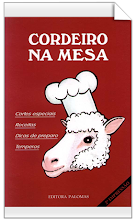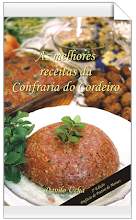O crítico de vinhos do Jornal da Noite voltou afiado de uma temporada nos campos do Caty, em Livramento. Depois do frio abaixo de zero entre Quarai e Livramento, está de volta ao sol carioca, bebendo um bom vinho e lendo jornais e revistas estrangeiros. Eis sua análise sobre dois textos de ingleses sobre o vinho brasileiro:
“Nos últimos meses tiveram destaque local notícias da imprensa internacional de elogios ao vinho brasileiro por parte de Tim Atkin da Harper´s e Will Lyons do Wall Street Journal, sobre uma viagem deste com Oz Clarke ao Vale dos Vinhedos. Tim Atkin, em sua Copa do mundo do vinho, desclassifica de cara Uruguai e Brasil, aquele por produzir só tannat (deve ser o Forlán) e nós por sermos produtores (VERGONHA DAS VERGONHAS!!!) de indignas vitis-labrusca.
Sobrariam para as semi-finais (só valem os países que disputaram a Copa) Argentina, Inglaterra (pelos atuais excelentes frisantes), França e Itália.
Argentina, embora com um grande jogador, o Malbec, e um grande time, com Cabernet Sauvignon, Syrah, Chardonnay e Torrontés, perderia pela falta de sutileza e elegancia, por manejo desconjuntado do carvalho e pela alta alcoolização. A Inglaterra peca pelo pouco volume de produção, pelo alto preço e pela fata real de classe.
Então a final ficaria entre França e itália. Mesmo sem prorrogação e pênaltis, seria parada dura e a França só ganharia porque na Itália não há nada parecido com um top puligny-montrachet, riesling alsaciano, sancerre, sauternes ou champagne.
Ao final, Tim Atkin seleciona um vinho, dos que se encontram à venda nos supermercados Londrinos, para cada país das quartas-de-final. Ao Brasil toca o Miolo Millésime, vendido, claro, pela Coe Vintners, onde trabalha o Dirceu Vianna Júnior.
O Wall Street Journal, na verdade, fez uma alerta, (que aliás, todos os críticos de vinho lúcidos vem fazendo há tempos). Que ao invés de melhorar a qualidade do vinho específicamente brasileiro, as vinícolas estão enveredando pela senda de copiar o estilo padronizado e macdonaldizado que preside o mercado mundial de vinhos. E conclui que, como os estrategistas de marketing mais competentes já concluíram, mantendo a nossa característica de frescor, sem madeira e altos em acidez, poderemos encontrar um nicho no mercado internacional. De outra maneira, a competição será dura e fadada ao nosso fracasso. Isto porque aí vai valer o menor preço e, como argentinos, uruguaios e chilenos já nos demonstraram no nosso próprio mercado, vamos levar goleada.
Diferenciação, senhores! Qualidade e Diferenciação! Aí poderemos colocar um preço que acomode o nosso enorme custo e não enfrentar a concorrência.
June 10, 2010, 12:06 PM ET
The Diversified World of Wine
Brazil is about as far off the wine route as you can travel. Last year I took a trip to its vineyards with British wine writer Oz Clarke. We visited the Vale dos Vinhedos in the Serra Gaucha mountain range, a steep drive from the coastal city of Porto Alegre. What we found was a wine culture steeped in the traditions of the Veneto, in northeastern Italy.
Will Lyons
The VenetoMany Italian immigrants arrived in Brazil in the late 19th century with clones of European grape varieties. During the course of our visit we tasted a series of sparkling wines, some Cabernet Sauvignon and Merlot. What really impressed us was that a lot of the wines were refreshingly high in acidity and were not aged in oak.
The sparkling wines had a rapacious acidity, with a fresh, clean, appley character and frothy mousse. Stylistically the wines reminded me of the light wines found in France’s Loire Valley or, fittingly, the Veneto, and provided a welcome contrast to the swathe of heavily oaked, high-alcohol wines that have come to dominate the international wine market. Alas, some of the winemakers I spoke to were keen to buy oak barrels, plant French grape varieties and produce wines similar in style to the wines those mainstream wines.
Why is it that everyone wants to emulate the great wine styles of Europe? My argument was that in keeping the unoaked, fresh style, Brazil could carve out a niche as a point of difference.
I was reminded of this trip on Monday, when I visited the Veneto region for a short field trip. The Veneto is synonymous with Prosecco, otherwise known as the wine that puts the fizz into a bellini.
A lot of critics argue that Prosecco shouldn’t be taken too seriously and I have some sympathy with that view. It’s light, fine appley character is a fine lunchtime aperitif in the summer but perhaps lacks the complexity of Champagne. One estate that might disagree is Bisol which does make serious Prosecco.
The Veneto is fizzing with energy as sales of Prosecco have risen in recent years due to cash-strapped consumers looking to trade down from other more expensive sparkling wines. But with increased revenue comes a desire to diversify. While I was in the Veneto I was served a red wine made from a blend of Bordeaux grape varieties. It was very good as Bordeaux blends go and at around 20 euros can compete. But why bother? Why not stick to making wine from the indigenous grape varieties of the region? If everyone plants Merlot and Chardonnay the world will become a slightly duller place.
Copyright 2008 Dow Jones & Company, Inc. All Rights Reserved
The Times
The Sunday Times
June 10, 2010
Winning wines for a World Cup knockout
The competition is being held in a producing country, and includes most of the important winemaking nations
Tim Atkin
For those of you who can’t wait for the last whistle, might I offer an alternative? My World Cup Wine Knockout is guaranteed to enliven even the dullest game. The concept is simple. Just open a bottle from the two competing countries and declare a winner, irrespective of the match result. Imagine how much more interesting the group game between, say, Chile and Switzerland will be if you have a carménère and petite arvine to hand.
Not all of the nations competing make wine, but a surprising number do ( try www.wine-searcher.com for stockists). For wine lovers, this is the best World Cup ever. Not only is the competition being held in a producing country, but it includes the majority of the important winemaking nations.
Previous form suggests that the winner will come from the shortlist of countries that have triumphed before. If I were writing a form guide to their wines, which country would be my champion? Uruguay is the easiest to eliminate, dependent as it is on a single red grape variety (tannat) for its reputation. Neighbouring Brazil would be next to go, despite its size (it makes more wine than Portugal), most of its grapes are low-grade vitis labrusca.
England would scrape the semi-final line-up. Our sparkling wines are great, but production is small and our other wines are over-priced and short of real class. Sound familiar?
Argentina has a star player in its red grape (malbec), and a strong squad too, featuring syrah, cabernet sauvignon, chardonnay and the near-native torrontés. Lack of subtlety — high alcohol and clumsy oak handling are persistent failings — would ultimately undermine its challenge.
Even without penalties or a spectacular head-butt, my France-Italy final would be difficult to call. Both teams have quality in depth. Where France would win, at least for me, is with its white and sparkling wines. There’s nothing as good as a top puligny-montrachet, alsace riesling, sancerre, sauternes or champagne in Italy. All of which is ironic when you consider that they didn’t deserve to qualify for the tournament. If Ireland had eliminated them, as they so nearly did, we’d be drinking Guinness instead.
World cup winners
Uruguay: 2009 De Lucca Tannat (£8, 12.3 per cent, www.winesofuruguay.co.uk) A bright introduction to Uruguay’s signature grape, with juicy plum and black cherry.
Italy: 2007 Asda Extra Special Primitivo Puglia (£6.98, 13.5 per cent) Primitivo is the same grape as Zinfandel, planted in California, but this has an Italian twist: savoury, spicy and ripe
Germany: 2008 Dr Bassermann Jordan Riesling, Pfalz (£8.99, 10 per cent, Waitrose) Rieslings from the Pfalz region tend to be almost tropical. This is peachy, pineappley and rich.
Brazil: 2006 Miolo Millésime Brut Vale dos Vinhedos (£11.40, 12.5 per cent, Coe Vintners) This is the best sparkler I’ve had from South America: fine bubbles and toasty character.
England: 2007 Ridgeview Cavendish (£19.99, or £15.99 by the case, 12 per cent, Oddbins) Inexpensive for an English fizz, this pinot meunier-dominated blend is crisp and refreshing.
Argentina: 2008 Tesco Finest Malbec Mendoza (£6.98, 13.5 per cent) Sourced from the excellent Catena winery, this violet-scented malbec from Mendoza is smoky and brambly
France: 2007 Côtes du Rhône Clos de Mont-Olivet (£7.49 each for two, 14 per cent, Majestic) 2007 was such a great vintage in the Rhône: juicey and unoaked with cloves.
Assinar:
Postar comentários (Atom)








Um comentário:
Hey admin, plumb educational blog post! Pleasee carry on with this awesome work..
[IMG]http://www.sedonarapidweightloss.com/weightloss-diet/34/b/happy.gif[/IMG]
[img]http://www.cpcstorm.com/co/images/6.gif[/img]
[img]http://www.cpcstorm.com/co/images/7.gif[/img]
[img]http://www.cpcstorm.com/co/images/8.gif[/img]
[img]http://www.cpcstorm.com/co/images/9.gif[/img]
[img]http://www.cpcstorm.com/co/images/10.gif[/img]
[img]http://www.cpcstorm.com/co/images/11.gif[/img]
[img]http://www.cpcstorm.com/co/images/12.gif[/img]
[img]http://www.cpcstorm.com/co/images/13.gif[/img]
[img]http://www.cpcstorm.com/co/images/17.gif[/img]
[img]http://www.cpcstorm.com/co/images/18.gif[/img]
Postar um comentário